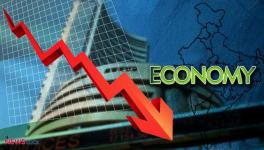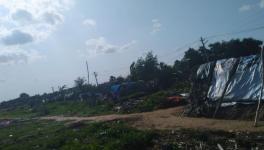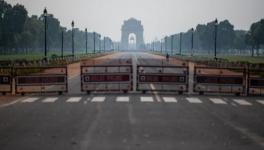New GDP Numbers Show How Modi’s Policies Destroyed Economy

Gross Domestic Product numbers released on May 29 reveal that India’s economy is sinking rapidly, continuing the trend that started last year. The provisional estimate for GDP growth for 2019-20 is now pegged at a mere 4.2% compared to 6.1% growth in the preceding year. But it is the quarterly estimates that throw up the dark picture.
As shown in the chart below, compared to the last quarter of the previous financial year (January-March 2018-19), this year’s last quarter has exhibited a very tepid growth of 3.1%.
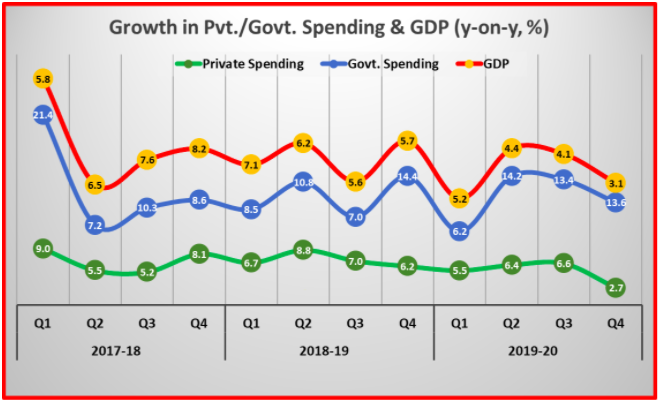
Remember that these numbers are for January-March quarter of 2020, that is, the last quarter of FY 2019-20. This was the period when SARS-CoV-19 first became identified as a new virus, and it started spreading across the world. Although the first case was identified in India on January 30, its progress was very slow here – by March 24, just 390 cases had been recorded, and nine deaths. So, these GDP numbers are a kind of trailer to what is certainly going to be a catastrophic April-June quarter when COVID-19 really hit India.
Private Final Consumption Expenditure (PFCE), which is the sum of all expenditure undertaken by households and corporations or businesses etc., grew by only 2.7%. This indicates the severe economic hardship being faced by the people, as also the deep reluctance of Indian businesses to spend money, because there are no buyers.
Government Final Consumption Expenditure (GFCE), the sum of all government spending grew at only 13.6%, compared to over 14% in the corresponding quarter of the previous financial year. This means that despite the slowing economy, the Modi government was unwilling to spend money and pull the economy out of the abyss it was sinking in.
Computing the quarterly sectoral growth rates over the past two years shows some good news but that’s more than compensated for by the double whammy of bad news. (See chart below) Agriculture is reported to have grown in the last quarter by an astonishing 9% compared to the corresponding quarter of 2018-19. This is mostly a base effect, because the agricultural gross value added in the previous year’s quarter was low due to floods and other factors, and hence the bounce back is magnified. But still it is good news of sorts.
On the other hand, manufacturing, construction, etc. (the secondary sector), which was sliding over the past year, actually contracted showing a ‘growth’ of – 0.16%. The services sector, that had been driving the economy till now, sank to a mere 2.73% growth in the last quarter. Put both these two sectors together and you get the picture of a disaster in making – they employ about 50% of the workforce and contribute to two thirds of the GDP. The slowdown is ominous for both – jobs and the economy as a whole.
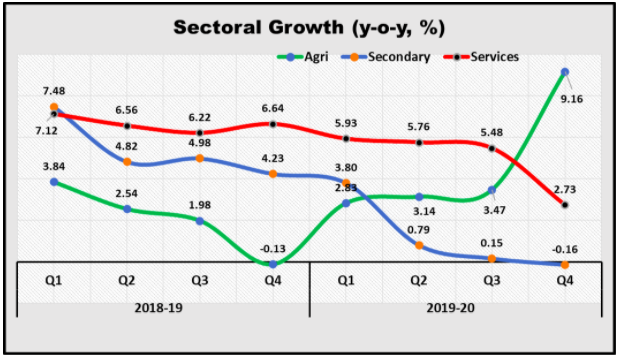
Modi’s Economic Policy Disaster
Why are these numbers so disastrous? Primarily, because they show that India was already in the grip of a slowdown [see charts], and the subsequent pandemic mishandling by the government would only further aggravate the crisis.
Economic growth was already plummeting, joblessness was raging at unprecedented levels, ranging between 7-9% for most of the year, and the only important factor that could have saved the situation from further deteriorating – government spending – was incredibly on a downslide. This last factor shows that the Modi government was firmly in the grip of the discredited neo-liberal dogma of cutting government spending in order to supposedly encourage private investment. They thought, erroneously, that private investment would kickstart the economy by creating new productive capacities, generating more employment, and thus creating more demand. Nothing of the sort had happened in the preceding several months, despite the Modi government’s massive cut in corporate taxes in September 2019, or setting up of funds to help the construction/real estate sector. Nor had easing of bank credit helped in more loans being taken by industry.
In fact, joblessness continued to grow, wages remained stagnant, and the most dire indicator of a highly distressed people was revealed in the fall in consumption expenditure by households in 2018, which laid the ground for the slowdown. This last bit of information came from an NSSO survey report that was leaked, and which the government didn’t release ultimately.
Lockdown Destroyed the Economy
In such a situation, the Modi government announced the unprecedented lockdown on March 24, which meant that the already sinking economy (as indicated by these numbers) was dealt a deathblow of sorts. Virtually all economic activity stopped, unemployment zoomed up to reach over 12 crore by April, lakhs of workers were left without even earned wages being paid to them, and forced to leave their workplaces to go back home. In the agrarian sector, belatedly, rabi harvesting was allowed but government procurement went into a tailspin, which means that farmers did not get even the paltry relief that minimum support prices offer.
Even government run programmes, like the rural job guarantee scheme (MGNREGA) were effectively closed down, till being restarted in the third week of April. This not only snatched away the limited earnings that were accruing from manual work, but it also would have damaged nutritional security. Information is not officially available about the massive mid day meal scheme, but all reports indicate that it floundered and ground to a stop.
All this has come on top of the already sinking economic condition as represented by the January-March GDP numbers. The Modi government has not only earlier failed to reboot the economy in any sensible way, but its neglect of the people has left the country extremely ill-prepared to deal with the devastating impact of the novel coronavirus. Had the government adopted different policies based on jacking up its spending, the economy – and the people – would have been in a much better position to face the COVID-19 pandemic and the ensuing economic mayhem.
The pandemic is yet to peak in India, but it is hurtling towards a grim zenith. But the economic condition of the people will take much longer to recover. India is going to face a very catastrophic economic crisis in the coming days, and sadly it is led by a blind and indifferent leadership
Get the latest reports & analysis with people's perspective on Protests, movements & deep analytical videos, discussions of the current affairs in your Telegram app. Subscribe to NewsClick's Telegram channel & get Real-Time updates on stories, as they get published on our website.









